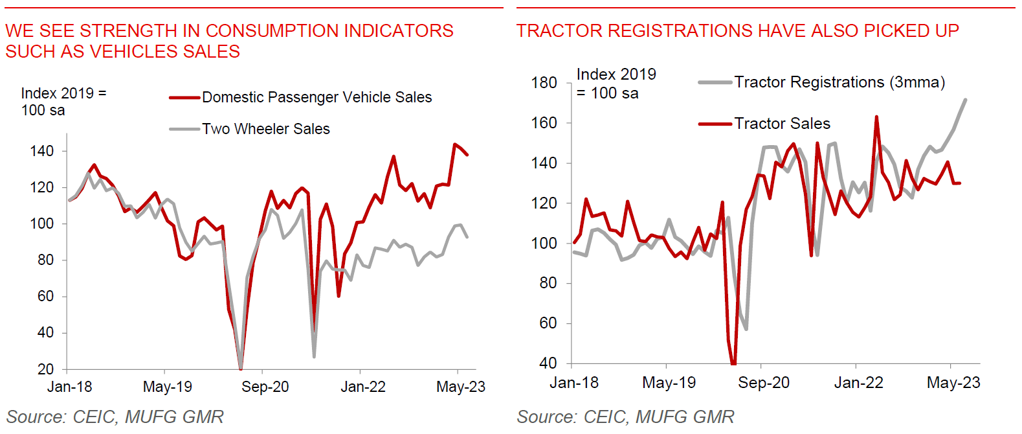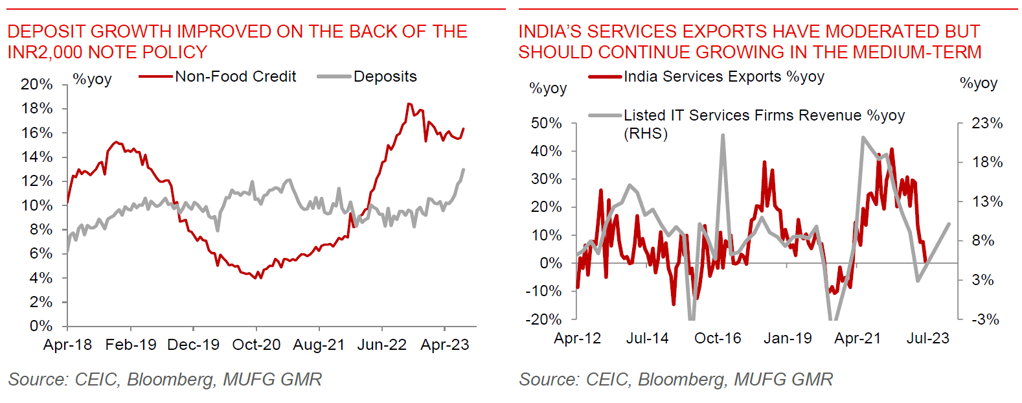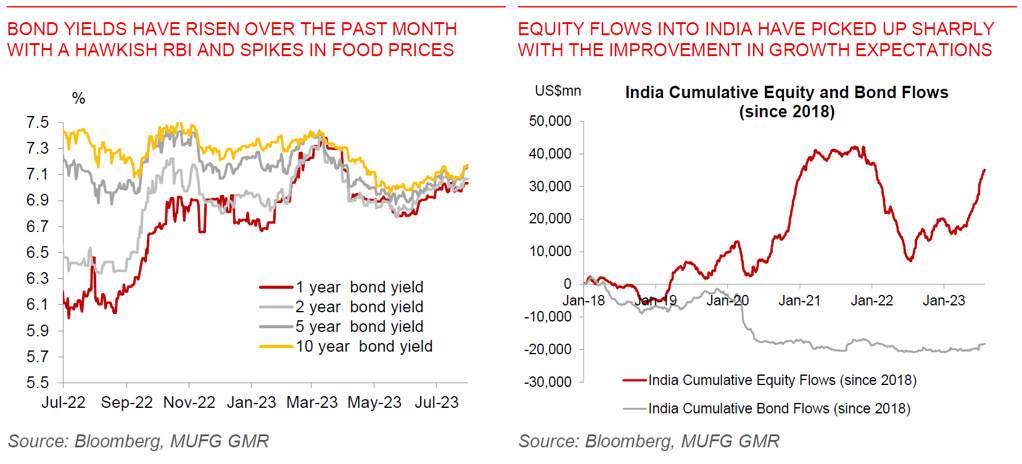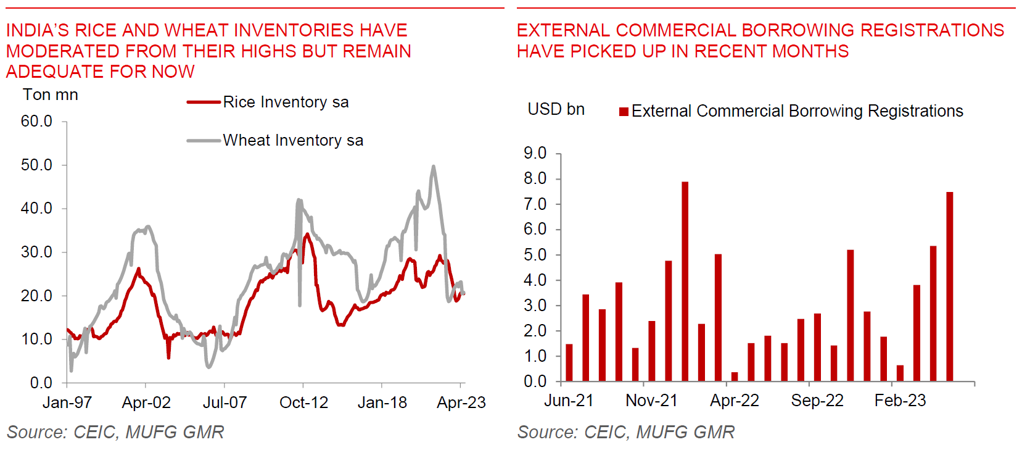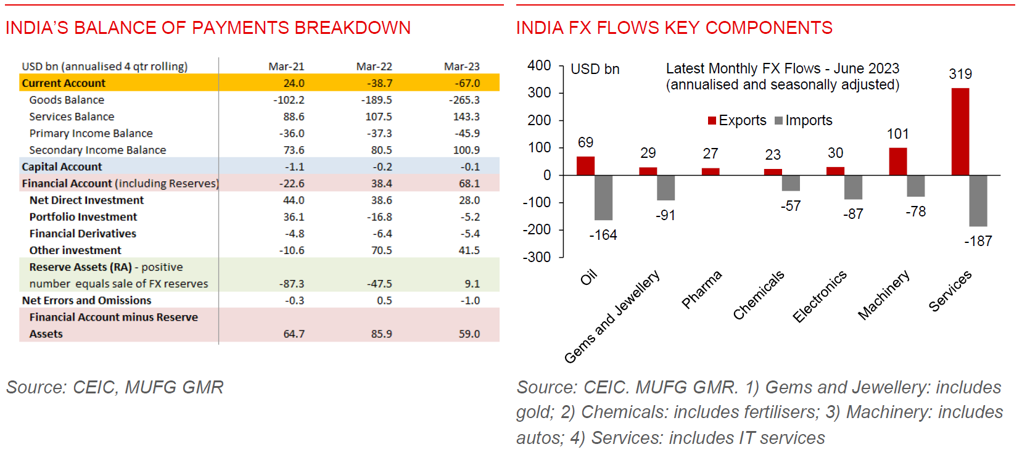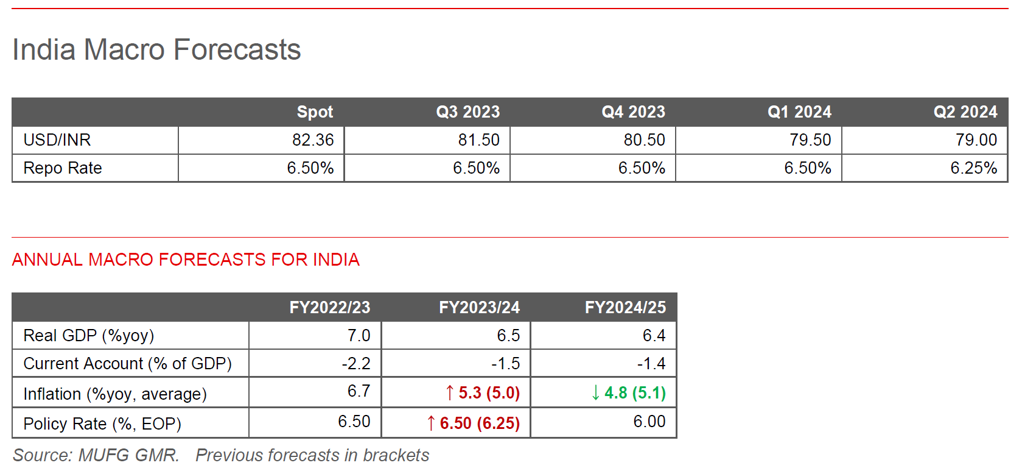Since our last IndiaPulse report, India’s economy has by and large moved in a positive direction, and in line with our sanguine view of India’s macro and FX (see IndiaPulse: Positives are lining up). Growth remains resilient, while inflation has moderated notwithstanding the recent spike in food prices. Flows are supportive of INR, with a comfortable current account deficit coupled with a pickup in portfolio flows.
The Southwest Monsoon and Kharif crop sowing have improved, although rainfall distribution remains uneven: Cumulative rainfall is now 6% above long-term averages in India, up from a 10% deficit in June. Some agriculture producing states are now experiencing a rainfall surplus, but key rice producing areas such as Uttar Pradesh and West Bengal remain in deficit. The good news is that Kharif crop sowing has picked up, especially for rice.
We raise our inflation forecast to 5.3% in FY2023/24 (from 5% previously), but lower our FY2024/25 estimates to 4.8% (from 5.1% previously): Our analysis shows that higher food inflation has not yet spilled over to other components of the CPI basket, with underlying inflation measures contained. We assume that food prices normalise over time, allowing inflation to moderate closer to trend at 5%.
We now forecast the RBI to cut rates by 50bps from the June 2024 quarter (previous: March 2024), bringing the repo rate to 6% by end-2024: We expect the RBI to maintain a hawkish tone for now and keep the repo rate on hold at 6.5%. Money market rates should trade close to the repo rate with the RBI maintaining its stance.
We remain positive on INR and continue to forecast USDINR at 81.5 in 3m and 79.0 in 12m: INR would likely be much stronger right now were it not for RBI’s FX intervention, given flows seen year-to-date. We continue to see fundamental support for INR given a manageable current account deficit of 1.5% of GDP, together with improvements in portfolio, FDI and External Commercial Borrowing. RBI’s FX intervention strategy cuts INR both ways, but we think RBI should over time allow USDINR to fall more in line with Dollar weakness through 2024.
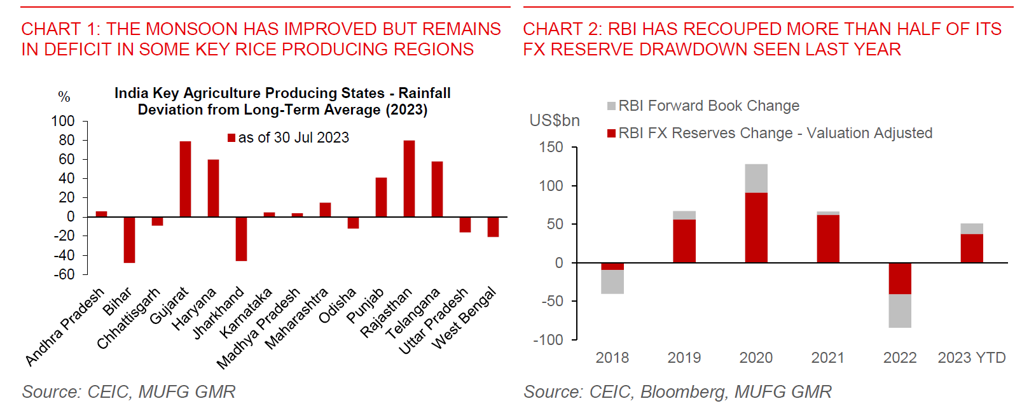
India's growth to remain robust at 6.5% in FY2023/24 and 6.4% in FY2024/25
India’s economic activity is generally robust, but with some loss of momentum in recent weeks. The high frequency and monthly indicators we track show economic activity picking up pace in the June quarter (see Charts 1 and 2 below). On the consumption front, we see continued strength in sectors such as vehicle sales (+16%qoq), tractor registrations (+11%qoq), and steady growth in GST collections (+3.8%qoq). Meanwhile, on the investment side, diesel consumption (+6.4%qoq), and finished steel production (+6%qoq) were strong. We have also seen some acceleration in government infrastructure spending (+49%yoy) and bitumen consumption (+6.4%yoy). Nonetheless, there was some loss of momentum in recent weeks for some indicators, but nothing which would cause us concern for India’s growth. For instance, domestic passenger air travel has slowed down, declining 1%mom in July, from a 5% mom fall in June. Railway freight dropped by 4%mom in June, highlighting some possible moderation in investment activity. Services exports have also slowed to -0.1%yoy, due to weakness in the IT services sector.
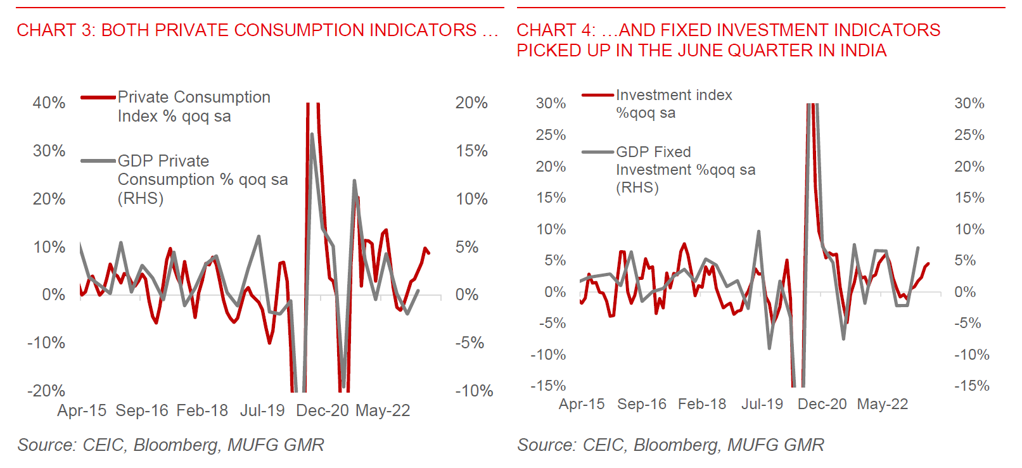
We remain positive on India’s growth prospects, although are watchful for downside risks arising from a deficient monsoon and a sharp slowdown in IT services exports: Forward-looking business surveys continue to point to improving economic activity over next few quarters (see IndiaPulse: positives are lining up). We see 3 fundamental drivers of this optimism. First input costs have already come off meaningfully, with WPI inflation declining 4.2%yoy as of June, and CPI moderating to 4.8%yoy in the June quarter (down from 6.2%yoy in the March quarter). This is notwithstanding the recent spike in food prices. This should be increasingly positive for corporate margins and consumer purchasing power. Second, the negative impact of previous rate hikes should increasingly fade with RBI likely on a prolonged rate pause. Third, the government’s infrastructure rollout will also crowd in private investment over time. Key risks we are monitoring for include a deficient monsoon, a sharper slowdown in IT services exports, and oil price spikes. Overall, we expect India’s growth to accelerate closer to 7% in 2nd half FY2023/24, before moderating thereafter to around 6%-6.5%.
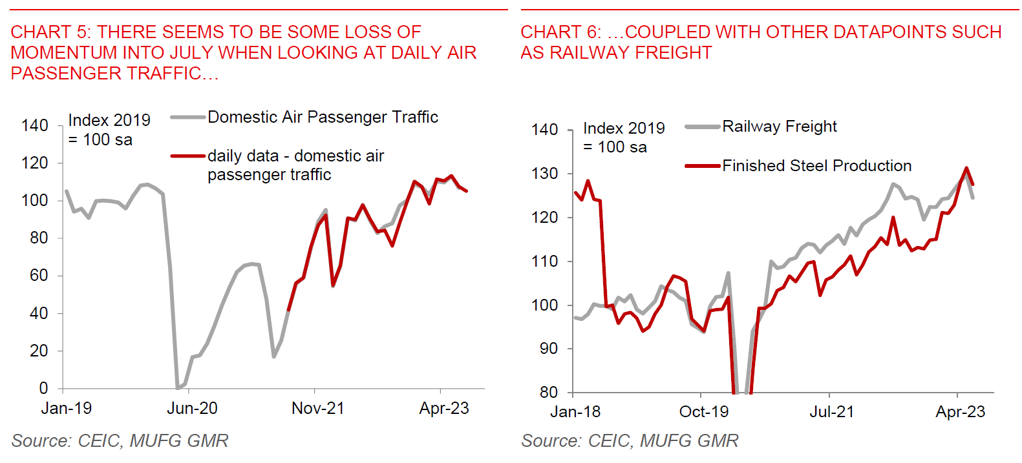
We raise our CPI forecast and push out our RBI rate cut forecast to start from June 2024 quarter
We have seen improvements in the monsoon and Kharif crop sowing in recent weeks
Food prices have increased due to a slow start to the monsoon and heatwaves: In particular, the spike in tomato prices has received the most public attention, with prices surging by more than 300% over the past 2 months (see Chart 7 below). Meanwhile, wheat and rice prices have also crept higher, while prices of some pulses such as Tur Dal increased sharply by 12.5% over the past 2 months. All in all, this means that headline inflation will likely rise above 6%yoy in July and August, from 4.8%yoy currently, based on the high frequency indicators that we track.
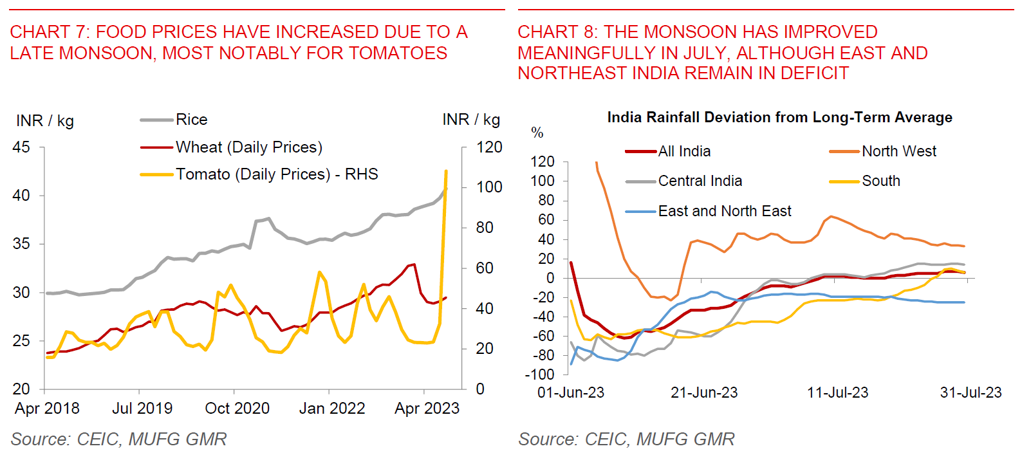

The good news is that there has been decent progress on the monsoon and Kharif crop sowing in recent months: India is experiencing a rainfall surplus of 6% above long-term averages, up from a 10% deficit at the end of June (see Chart 8 above). The distribution of rainfall has also improved over the past few weeks. For instance, 9 key agriculture producing states, including Andhra Pradesh, Karnataka, Maharashtra and Telangana faced a deficit of rainfall 3 weeks ago (see Chart 9). As of 30 July, this has narrowed to 6 agriculture producing states, all be it that some of these states such as Uttar Pradesh and West Bengal are very important agriculture producers of rice, vegetables, fruits and sugarcane. Reservoir levels have also risen above long-term averages, with meaningful improvements in the Southern region. Meanwhile, Kharif crop sowing area has also improved meaningfully over the last 2 weeks especially for rice (see Chart 10). Given the uncertainties surrounding the monsoon and agriculture production, we expect India’s government to maintain its recent export ban on non-basmati white rice for the foreseeable future, with risk that it may be broadened to include other varieties of rice. This is important to watch for as it may increase the chance of export bans by other rice producing countries.
We expect food prices to normalise over the next few months, although we remain watchful of risks
We raise our forecast for FY2023/24 inflation to 5.3% (from 5% previously), while lowering our FY2024/25 inflation forecast to 4.8% (from 5.1%). Overall, we assume that food prices normalise post the current spike that we are seeing, given the decent albeit uneven progress we are witnessing from the monsoon, Kharif crop sowing, and reservoir levels. More importantly, our analysis of underlying inflation trends in India such as through trimmed mean and core inflation shows that higher food inflation has not yet generalised and spilled over to other components yet. For instance, core inflation is still rising gradually at around 0.3% mom sa as of June. Trimmed mean inflation, which excludes the 30% most volatile items in the CPI basket, declined to 3.6% on a 3-month annualised change basis in June, from 5.6% in the 1st quarter of the year (see Chart 11 below). Inflation diffusion measures shows that the share of items experiencing more than 4% inflation has fallen sharply to 40% of the basket in June from 70% of the basket last year, with a slight rise in the recent print (see Chart 12 below).
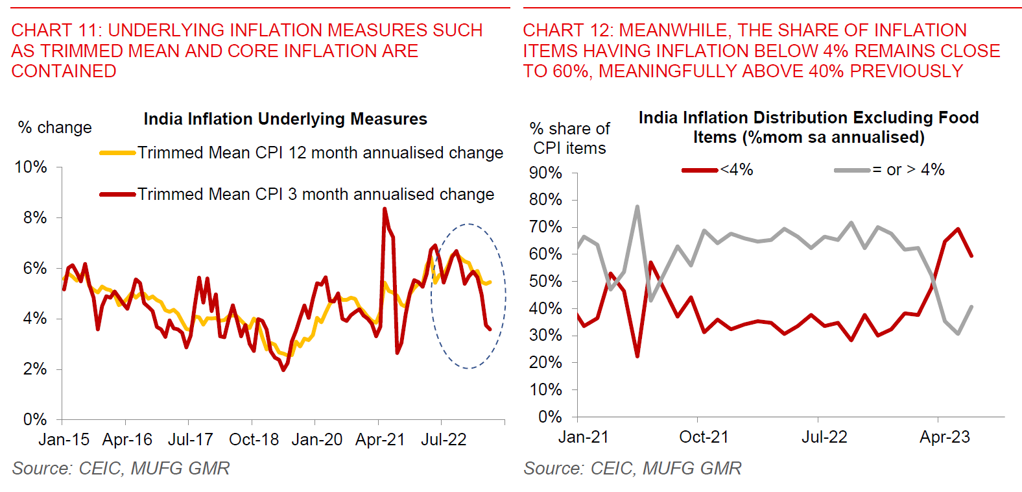
We push out our forecast for RBI rate cuts to June 2024 quarter (from March 2024 previously). We still think the next rate move is likely a cut. Suffice to say, RBI should keep a hawkish tone for now given the risks on food inflation and uncertainty on the monsoon, coupled with lack of clarity on the Fed’s rate path. We expect the RBI to maintain its current stance of “withdrawal of accommodation”, at least until we see more meaningful signs of improvement in food prices. Money market rates are likely to trade close to the repo rate this year, and RBI should continue with its operations to withdraw liquidity.
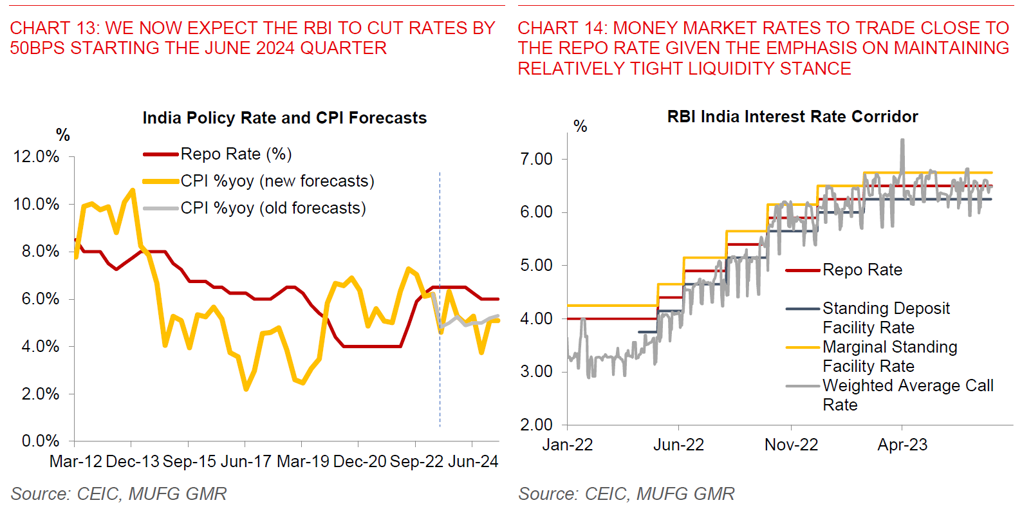
We maintain a positive view on INR and forecast USDINR at 81.5 in 3m and 79.0 in 12m
We expect India’s current account deficit to remain manageable at around 1.5% of GDP this fiscal year, before narrowing slightly next fiscal year: Looking beyond growth and inflation, the external picture still looks quite good for India. The key for INR is not just that growth is resilient, but that this is also occurring together with macro stability, with a manageable current account deficit, stable credit growth and decent core inflation trends. We expect the current account to remain manageable at a run-rate of 1.5% of GDP this year. The goods deficit should widen somewhat given the rise in domestic demand we expect, coupled with a gradual increase in oil prices. Looking at other components of the current account deficit, we expect remittances to continue growing at a healthy clip of more than 10%, which can partly offset the wider goods deficit we forecast. Meanwhile, we expect services exports growth to slow given weakness in the IT services export sector, but to remain at high levels annualising slightly under US$140bn. The long-term prospects for India’s IT services sector remain strong, and we expect services exports to resume growth as we head further into 2024.
Funding the deficit should be relatively easy with improvements in portfolio, FDI and External Commercial Borrowing Flows: What’s as important for INR’s trajectory is whether India’s current account deficit can be funded. On this front, we are quite sanguine. Portfolio flows have resumed and have more than reversed outflows since the start of the year, although the levels admittedly look slightly stretched in the very near-term. Meanwhile, FDI flows have no doubt seen a soft patch, but we think this should recover on the back of commitments from companies to invest in manufacturing production capacity in India. External Commercial Borrowing registrations have also picked up, and this tends to have a good relationship historically with changes in the Fed Funds rate.
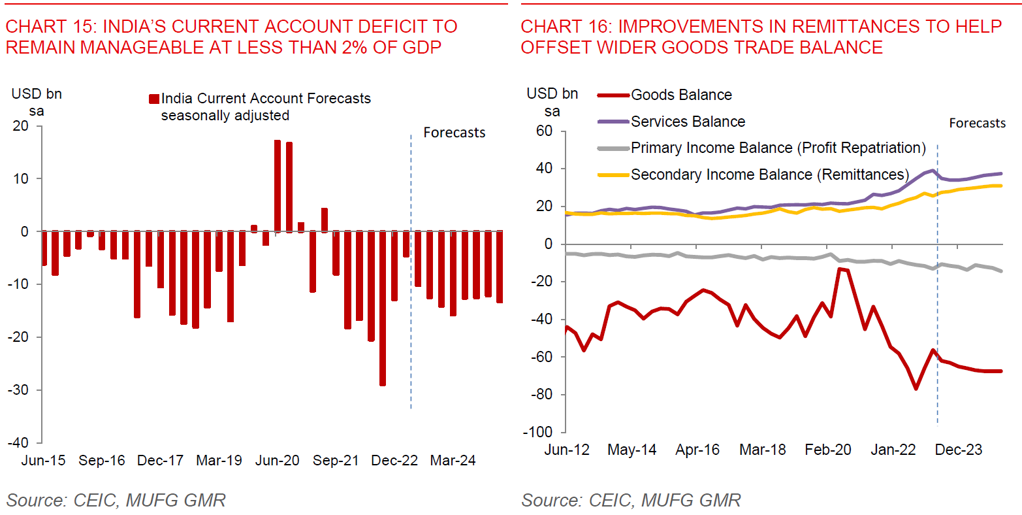
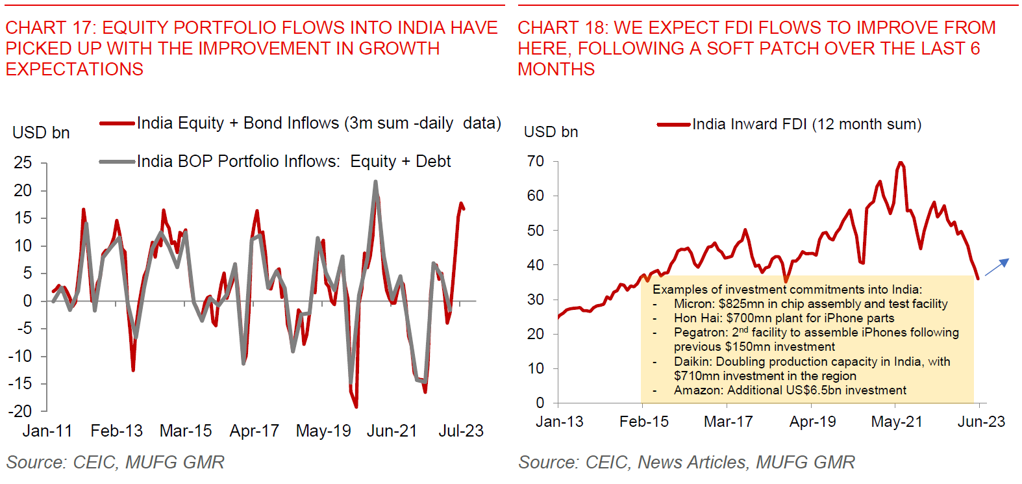
We remain positive on INR and see USDINR at 81.5 in 3months and 79.0 in 12months, reflecting a narrower current account deficit and better macro stability: We think the overall balance of payments position in India should be in a comfortable surplus this year. RBI’s FX intervention strategy however is crucial and cuts both ways. Were it not for RBI’s aggressive purchasing of US Dollars, INR would probably have strengthened more. Overall, we think RBI should over time allow USDINR to fall more in line with Dollar weakness through 2024, and with INR’s FX valuations not exorbitant and remaining below long-term averages.
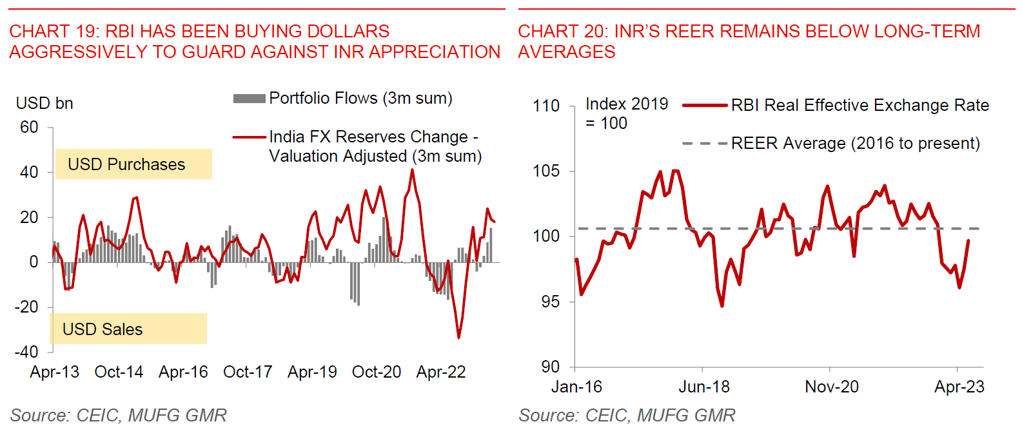
India Policy Tracker
Appendix: India Private Consumption and Investment Trackers
We introduce 2 growth trackers for India in this report, one for private consumption and another for investment activity. These indices incorporate the latest monthly real sector indicators such as passenger vehicle sales, petroleum and diesel consumption, steel production, and capital goods imports, coupled with key economic indices such as the industrial production and infrastructure industries index. We also track other monthly numbers such as GST revenue collection, rural wages and unemployment rates which give us a sense of the direction of travel, but are not as suitable to be included in an index.
Tracking these high frequency datapoints above is important for at least two reasons. First, the central bank tracks many of these data closely (for instance, see links here and here). Understanding their evolution will allow us to better forecast the central bank’s policy considerations, with a view to getting ahead of the curve. Secondly, having an updated view of India’s macro can allow us to better anticipate turning points in the economy and the associated market implications, given the significant uncertainty surrounding the global economy now.
India In Charts
